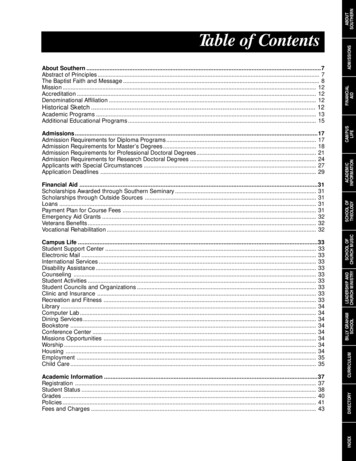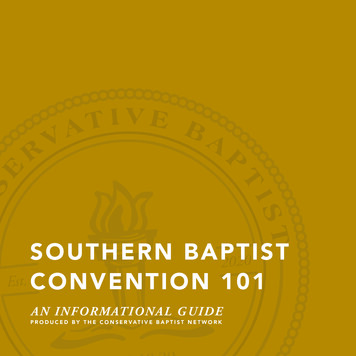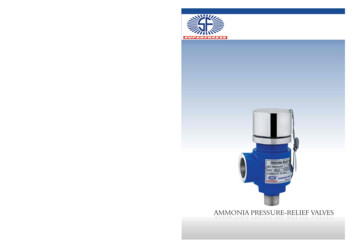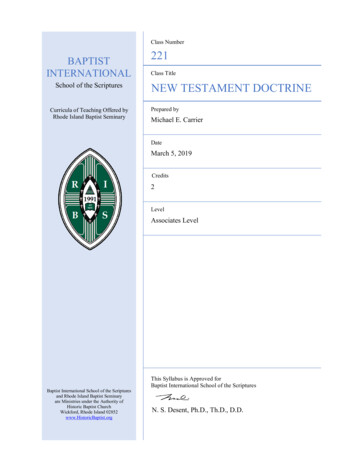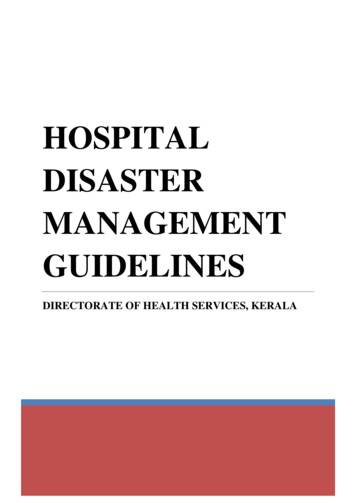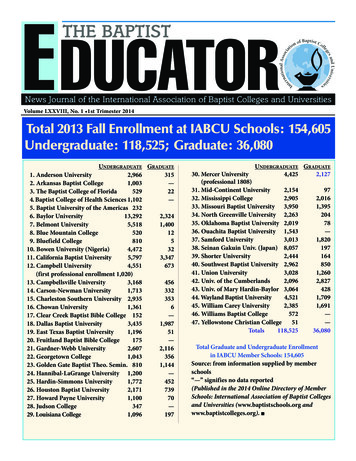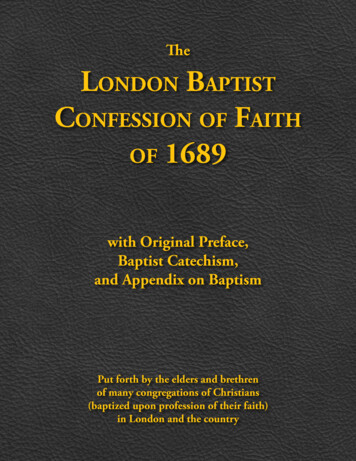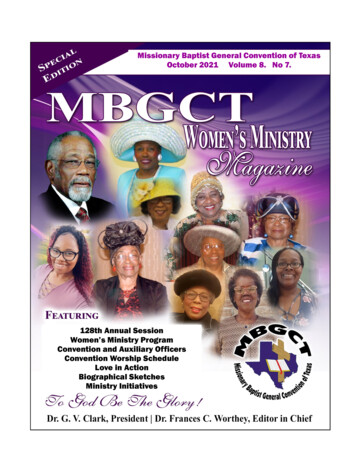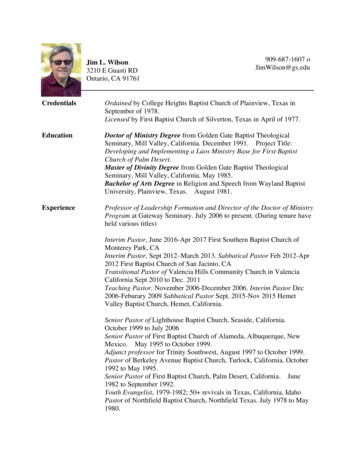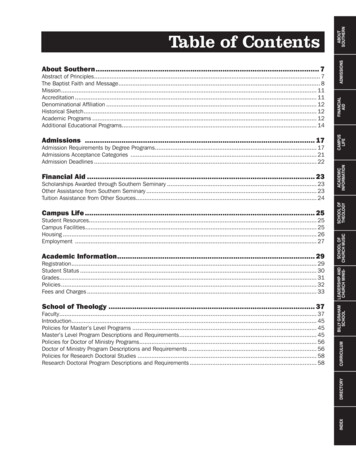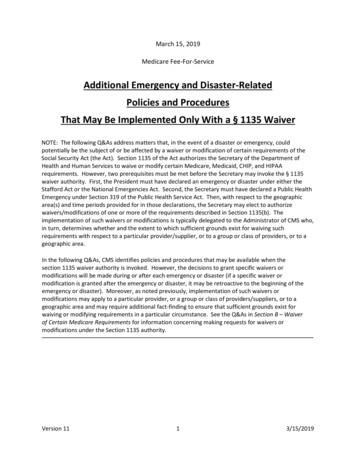
Transcription
Southern BaptistDisaster ReliefChaplain TrainingManualDecember 2016North American Mission Board, SBC
Table of ContentsObjectivesUNIT 1UNIQUENESS OF CRISIS MINISTRY IN DISASTERS. 1Introduction: History of Crisis Ministry . 1What Is So Unique About a Chaplain in Disaster?. 2Spiritual Rationale for Chaplains in Disasters . 5Demonstrating Compassion is Being Present in Suffering . 5Demonstrating Compassion is Being Sensitive to Human Diversity . 7Demonstrating Compassion is Providing the Ministry of Care in Crisis . 8Ministry Tasks of the Chaplain in Disasters . 10Differences Between Chaplains in Disasters and Community Clergy. 11UNIT 2OVERVIEW OF THE CRISIS RESPONSE. 14Understanding the Terminology and Concepts. 14What Constitutes a Disaster? . 16Types of Disasters. 17What Happens During A Community Disaster?. 17Who, What, When, Where, Why, and How of Crisis Response. 19Victim Classifications. 20Emerging Issues for People and Groups Involved in Disasters. 20UNIT 3HUMAN NEEDS AND DEVELOPMENT. 22Maslow’s Hierarchy of Needs—Identifying the Crisis. 22Physiological Needs . 22Safety and Security Needs . 22Belonging and Social Affiliation Needs . 23Self-Esteem Needs . 23Self-Actualization Needs . 23Identifying the Crisis . 24Stages of Human Development—The Age-Specific Human Response to Crisis. 25Conclusions and Applications. 27Eight Stages of Life Chart for Crisis Intervention . 29UNIT 4OVERVIEW OF THE TRAUMA RESPONSE. 30Distress as the Trauma Response. 30The Nature of Stress . 30The Internal Trauma Response . 30Biological Factors—Physical Response . 32Psychological Factors—Mental Response. 32Social Factors—Relational Response . 34Behavioral Factors—Action Response . 34Spiritual Factors—Faith Response . 34Crisis Intervention as a Response to Trauma. 35Stress Symptoms Chart . 36Revised version 2016Page ii
UNIT 5THE ART OF STORY-LISTENING. 37Differences Between Hearing and Listening . 37Ethics of Listening . 37Ministry of Presence . 38Ministry of Silence. 38Improving Listening Skills . 39Clarify . 39Paraphrase. 39Summarize. 40Echo . 40Reflect. 40UNIT 6CRISIS INTERVENTION MODELS. 41Crisis Intervention. 41nternational Critical Incident Stress Foundation (ICISF) . 43Effective Disaster Relief Includes Trained Chaplains as Part of the . 43Interdisciplinary Team in Disasters and Other EmergenciesSummary. 45UNIT 7COMPASSION IN CRISIS. 46Demonstrating Compassion is Being Present in Suffering . 46Demonstrating Compassion is Being Sensitive to Human Diversity. 47Demonstrating Compassion is Providing the Ministry of Care in Crisis. 48Compassion at the Scene . 49What to Be. 49What to Have. 49What to Say . 50What to Do . 51Compassion Fatigue. 51Reactions to Long-term Stress . 51Signs and Symptoms of Compassion Fatigue. 54Basic Self-Care . 54UNIT 8COMFORTING GRIEF IN DISASTERS. 56Elements of Grief. 56Defining Grief . 56A Picture of Grief . 56Losses that Lead to Grief . 57Grief Is a Process . 58Comforting Grief . 61Complicated Mourning . 61Lesson Learned . 62Revised version 2016Page iii
UNIT 9SPIRITUAL DIMENSIONS OF TRAUMA. 64Overview of Spirituality in Trauma . 64Role of Religion and Spirituality . 65Spiritual Issues and Questions from Victims and Survivors. 66Religious Coping Styles. 67Spiritual Interventions for Disasters . 68Red Flags for Disaster Chaplain Interventions . 69Ethics of Chaplain Interventions in Disasters . 69What Victims Want to Say to Disaster Chaplains . 70Conclusion . 71UNIT 10MINISTERING IN THE MIDST OF DIVERSITY . 72Contextualized Ministry is Cross-Culturally Competent. 72Intentional Cultural Diversity Creates Multiple Needs . 72Cultural Perspective Affect Trauma and Recovery. 72Demonstrating Respect for Cultural Differences. 73Maintaining Personal Faith. 74“Red Flags” for Chaplains in Diversity . 74“Relief” for the Chaplain in the Context of Cultural and Religious Diversity . 74Principles for Ministering in Diversity . 75Chaplains Must Recognize the “UNKNOWN GOD” in Diversity . 76Clarifying Cultural Needs . 77Summary. 77Chart: Common Religious and Cultural Customs Concerning Death . 78UNIT 11WHAT TO DO NEXT . 79Pre-Training Requirements. 79Training Requirements. 79Advanced Training Requirements . 79Train-the-Trainer Requirements . 80UNIT 12RESOURCES FOR DISASTER RELIEF CHAPLAINS . 81Agencies. 81Professional Organizations . 82Community . 83Literature and Music. 83Contacts . 83Endnotes. 842004, 2007 North American Mission Board of the Southern Baptist Convention, Alpharetta, Georgia.All rights reserved.Revised version 2016Page iv
Unit 7Unit 6Unit 5Unit 4Unit 3Unit 2Unit 1Ministering in the Midst of DiversityThe Spiritual Dimensions of TraumaComforting Grief in DisastersCompassion in Disaster CrisisCrisis Intervention ModelsThe Art of Story-ListeningOverview of the Trauma ResponseHuman Needs and DevelopmentOverview of the Crisis ResponseTopicUniqueness of Crisis Ministry in DisastersUnderstand the basics of cultural and religious diversityUnderstanding the principles for ministering in diversityUnderstand the role of religion and spirituality in crisis interventionUnderstand the basic spiritual issues of victims and survivorsKnow some basic crisis interventionsUnderstand the basics of grief and lossUnderstand the expressions of lossKnow how to comfort griefUnderstand the ministry of compassionUnderstand how to demonstrate compassion at the sceneRecognize the symptoms of compassion fatigue and how to do selfcareBe aware of different crisis intervention modelsCISM, OSFAKnow the difference between listening and hearingUnderstanding confidentiality, presence, silenceUnderstand the art of story-listeningUnit 9Unit 12Unit objectiveKnow the difference between being a church pastor and a communitychaplain in disaster reliefUnderstand the basics of crisis response – what’s crisis,who are the victims, who are the caregivers, when to respond,whose lead to followUnderstand how to determine what the basic human need isduring crisis intervention and how to respond with the correctinterventionUnderstand holistically what happens to a victim during a crisisUnit 10What to Do NextPre-training requirementsTraining requirementsAdvanced training requirementsTrain-the-Trainer RequirementsUnit 8Unit 11Resources for Disaster Relief ChaplainsKnow how to get basic resources for referralsKnow who to contact for resourcing helpHave a detailed bibliography for books, articles, and internetresourcesRevised version 2016
UNIQUENESS OF CRISIS MINISTRY IN DISASTERSUNIT 1Introduction: History of Crisis Ministry1The development of chaplain ministry has its roots in ancient history.Religious men and women often accompanied armies into battle as priests.From the settlement of Canaan through the period of the judges, spiritual leadersprovided encouragement and compassionate care to people who were constantlyin crisis. Chaplains sailed with Sir Francis Drake in the sixteenth century andfought with Washington during the Revolutionary War. They prayed throughhuman suffering, encouraged in despair, and officiated over ceremonial events.They have counseled and consulted for kings, parliaments, and governments—for the incarcerated, the sick, and the disenfranchised.Chaplains have providedcompassionate carethroughout historyToday, chaplains are found in many settings—military, healthcare, lawenforcement, institutions, business and industry, resorts, racetracks, gamblingcasinos, job corps, shelters, rescue missions, professional sports teams, factories,and corporations. Placement is limited only by the lack of imagination.The word “chaplain” originates in fourth-century France. A traditionalstory relates the compassion of St. Martin of Tours. One cold and wet night, hewas so moved by compassion for a beggar, he shared his cloak. Upon his death,his cape (capella in Latin) was preserved as a holy relic and kept in a shrine thatcame to be known as chapele from which the English word chapel is derived.The guardian of the chapele became known as the chapelain. Today, thechaplain continues to guard the sacred and to share his cape out of compassion.Chaplains guard what is sacredin people’s livesOne growing specialization in chaplain ministry is disaster reliefchaplaincy. Military chaplains, hospital chaplains, law enforcement chaplains,and others have often ministered during difficult crises and emergencies, but thedisaster relief specialization has emerged during the past 15 years, albeitinformally. Most chaplains respond to the crises within their own organizations(the Army, the hospital, the police department), but many respond to the generalcommunity during community emergencies. Disaster relief chaplains often servemultiple agencies and usually respond to the general community of victimsduring the crisis. Victims may include innocent bystanders, direct victims,rescue and relief workers, and even the perpetrator of crimes (the arsonist whostarts the forest fire, the drunk driver who causes the multi-car fatality, or theterrorist who plants the bomb).Disaster relief chaplaincy is aspecialized form of chaplainministryIn the past, professional chaplains from many arenas of service haveresponded to major disasters; however, many have not been trained for theunique needs and issues that surround emergency disaster care. With greaterawareness for the value of spiritual care in conjunction with physical care duringemergencies, the disaster relief chaplain specialization has evolved into a majorchaplain category.Revised version 2016Page 1
The Southern Baptist Disaster Relief organization, the most highlyrecognized denominational disaster relief assemblage of many autonomous stategroups, has cooperated with the American Red Cross in developing effectivedisaster relief services, including chaplains who provide spiritual care. MickeyCaison, former national director for Southern Baptist Disaster Relief, reports thatchaplains have provided ministry during many Southern Baptist Disaster Reliefefforts following tornadoes (1996, 1997, 2007), hurricanes (1989, 1992, 2005),floods (1997, 2007), wildfires (2007), and terrorism (1995, 2001).Southern Baptists arerecognized disaster reliefcaregiversIn parallel development, the American Red Cross formally began deployingthe Spiritual Care Aviation Incident Response Team (now called SpiritualResponse Team – SRT) disaster relief chaplain teams to airline disasters on June1, 1999, upon the crash of American Airlines Flight 1420 in Little Rock, Ark.Today the SRT deploys to many mass casualty incidents with Red Cross trainedvolunteers. Furthermore, since the advent of formalized chaplaincyorganizations, including the International Conference of Police Chaplains in1973 and the Federation of Fire Chaplains in 1978, emergency response agencieshave used their departmental chaplains during disasters to minister to their ownpersonnel.The growing awareness of spiritual needs in crisis has begun to formalizethe response of disaster relief chaplains. National and international disasterrelief agencies are beginning to work together to coordinate spiritual careresponse in disasters of many kinds. With technological advances and theglobalization of America, relief agencies have recognized the need to redefinethe arena of disasters. It is no longer only the site/location directly impacted bythe disaster, but now includes remote locations, institutions, and people groupswho are in some way related or impacted by the disaster (e.g., the departure andarrival airports, the out-of-state corporate headquarters, the home church of thechildren in the bus, the manufacturer and factory of the faulty electrical switch).The need for spiritual and emotional support far exceeds the disaster location,hospital, or disaster shelter.What Is So Unique About a Chaplain in Disasters?The definition of spiritual care is derived from the biblical image of theshepherd who cares for a flock. In a very broad and inclusive way, spiritual careincorporates all ministries that are concerned with the care and nurturing ofpeople and their relationships within a community. This could include theclassic approaches—interpretation, prayer, meditation—or some of the morecontemporary approaches that have been influenced by training bodies such asthe American Association of Pastoral Counselors and the Association ofProfessional Chaplains—presence, listening, and reflection. In disasters,spiritual care is often pictured as providing a calm presence, nonjudgmentallistening, caring interventions, and the hope one can have through faith in JesusChrist.Spiritual care is leading,guiding, nurturing, sustaining,healing, and restoringDisaster relief chaplains come from a variety of professions and ministries.They may be pastors, chaplains, counselors, teachers, social workers, orChaplains include pastors andlaityRevised version 2016Page 2
psychologists. Disaster relief chaplains may also be laity—men and women whorespond to God’s call upon their lives to provide care and compassion to hurtingpeople during the crisis of disasters.Who are some chaplains you have known?Disasters are critical events and critical events often cause crisis for thosewho are involved. The American Red Cross reports that 59 percent ofAmericans would be likely to seek counsel from a spiritual care provider in suchcircumstances.2 Chaplains need to utilize their particular role and skills in anintentional manner to enhance the coping capabilities and spiritual reactions to adisaster. Providing spiritual care in the wake of disasters often involvesintegrating spiritual responses with other kinds of help provided by emergencycare responders, mental health providers, and social care agents. Such help isbest managed through the framework of established crisis interventionprinciples. Spiritual care providers should understand how variousrepresentatives of the other caring components typically operate in considerationof these principles.Victims seek spiritual care indisaster crisesThere are organizations that provide significant settings for understandinghow to integrate spiritual care with other care efforts during a crisis. One is TheInternational Critical Incident Stress Foundation (ICISF) This organization haswell-established methodologies for crisis intervention and can assist chaplains inbecoming more informed about how to interact with other care providers.Examples of the ICISF model are presented in Unit 6.One unique aspect of many chaplains serving in disasters is that theseproviders are usually pastors or laity; therefore they do not work in a disasterenvironment on a routine basis and would not be considered professional disasterrelief personnel. Instead, these chaplains are often volunteers from a variety ofspiritual care settings who participate in training and gain significant disasterrelief experience in order to be prepared for a response when spiritual needsemerge. These volunteers are usually trained and organized by organizationslike The American Red Cross, The Salvation Army, Billy Graham EvangelisticAssociation, and other similar entities. Among Southern Baptists, state Baptistconventions recruit, train, and deploy chaplains, cooperating together with thenetworking leadership of Southern Baptist Disaster Relief when multistateinvolvement is needed. All of these entities respond to crisis out of a caringconcern for those suffering injury, loss, or some other form of crisis.Chaplains in disasters provide caring ministry on the field of disasters,during and after the disaster occurrence, to any victim of the disaster, for a fewseconds or for a few hours. As these caregivers receive specialized training incrisis and spiritual interventions, much of the specialized training is built uponthe previous education and experience of the chaplain.In addition to the ministry of presence, ministry of compassion, andattentive listening, spiritual caregivers may choose from a number ofintervention methods that are uniquely theirs as people of faith and spirituality(see pages 68, 69):Revised version 2016Page 3
Scriptural education, insight, reinterpretationIndividual and conjoint prayerBelief in intercessory prayerUnifying and explanatory worldviewsVentilative confessionFaith-based social support systemsRituals and sacramentsBelief in divine intervention/forgivenessBelief in a life after deathUnique ethos of the crisis interventionistUniquely confidential/privileged communicationsWhat do disaster chaplains do?1.2.3.How do disaster chaplains get their training/education?1.2.3.In a few sentences, write a paragraph about why you would like to be a disasterchaplain.Why do you want to be adisaster relief chaplain?Revised version 2016Page 4
Spiritual Rationale for Chaplains in Disasters3Demonstrating Compassion Is Being Present in SufferingW. E. Vine defines being moved with compassion as being moved inone’s inwards (bowels).4 The splanchma are the entrails of the body. Modernvernacular might translate this as having deep feelings in one’s “gut.” This is thecenter of one’s personal feelings and emotions—love and hate—the feelings thatemanate from one’s “heart.” When the Gospels speak of Jesus’ compassion,they speak of deep, powerful emotions that far exceed the superficial feelings ofregret, distress, or remorse.Compassion is felt in one’s“gut”The English word compassion comes from two Latin words, cum andpati, which form the meaning, “suffer with.” It is “. . . a feeling of deepsympathy and sorrow for another who is stricken by suffering or misfortune,accompanied by a strong desire to alleviate the pain or remove its cause.”5“Compassion asks us to go where it hurts, to enter into places of pain, to share inbrokenness, fear, confusion, and anguish. Compassion challenges us to cry outwith those in misery, to mourn with those who are lonely, to weep with those intears. Compassion requires us to be weak with the weak, vulnerable with thevulnerable, and powerless with the powerless. Compassion means fullimmersion in the condition of being human.”6 Compassion enters into thesuffering and pain of the one who suffers. It is more honorable than pity andmore courageous than sympathy. Complete empathy for the desolation and griefof those who are suffering requires compassion.Compassion enters into thesuffering and pain of the onewho suffersDisaster chaplains mustThe disaster relief chaplain must know his or her own biases, needs, andintentionally choose a disasterlimitations and still deeply desire to identify with the disenfranchised and therelief ministrywounded, seeking to demonstrate the compassion of Christ as the priority ofchaplain ministry. Merely attempting to prevent suffering or not be the cause ofsuffering will be inadequate. The disaster relief chaplain must approach ministryfrom a radically different paradigm—the chaplain must initiate and be an activeparticipant in “being” compassion as a priority and “doing” compassion as anecessity.7 Recognizing one’s own natural instinct to excuse oneself from thecrisis, the chaplain must still choose to become engaged in the suffering. Thesignificance of being compassionate may lay in the fact that being compassionateis not an activity one naturally seeks, but an activity that one must intentionallychoose, knowing that it “feels” contrary to natural instincts.The theological foundation for disaster relief chaplaincy is supportedthrough the mandate to bear one another’s burdens (see Gal. 6:28); and therefore,“You must be compassionate just as your Father is compassionate” (Luke 6:36,NLT). The cup of cool water and the Good Samaritan also reinforce thisimperative.“You must be compassionatejust as your Father iscompassionate” (Luke 6:36,NLT)A vital aspect of disaster chaplaincy is “the ministry of presence.” “Amajor premise of care amid crisis is presence. The care of souls first requiresbeing there. Simple, empathic, listening presence is a primary pastoral act, thepresupposition of all other pastoral acts.”9 The power of this ministry is in itsaltruistic service. If chaplains provide compassion by bearing another’s burdens,then chaplains choose to “suffer with” those who are suffering. ProvidingA vital aspect of disasterchaplaincy is the “ministry ofpresence”Revised version 2016Page 5
compassion requires stepping out of one’s comfort zone and intentionallyentering a place of crisis—danger, pain, loss, or grief—during the spiritual andemotional crises of life.God is present in the sufferingThe strength of a caregiving relationship is in the fact that one is neveralone. God is present with the chaplain. The presence of God within theministry situation empowers the chaplain to provide effective, appropriatespiritual support within the context of disaster.Henri Nouwen calls the incarnation of God the “divine solidarity.” It is thecompassionate God who chooses to be God-with-us. The chaplain in disastersoften represents the presence of God.In 1893, Francis Thompsonportrayed God’s presence asthe “Hound of Heaven.” Nomatter where he fled, no matterwh
The American Red Cross reports that 59 percent of Americans would be likely to seek counsel from a spiritual care provider in such circumstances.2 Chaplains need to utilize their particular role and skills in an intentional manner to enh
